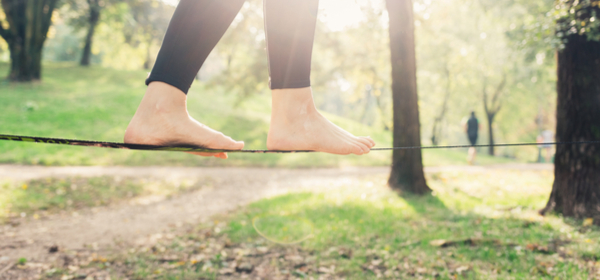What controls balance? Worryingly, current research suggests that one in three people over the age of 65 has experienced a fall over the past 12 months. However, with practice, it is possible to improve balance and reduce the likelihood of falling.
First, it’s important to understand how the body maintains balance.
Balance requires several systems around the body working in sync in order to provide feedback and keep you upright. These include the vestibular (inner ear) system, the visual system and the proprioceptive/muscular system.
The vestibular (inner ear) provides feedback to the brain to monitor the position and motion of your head. Several structures in the inner ear monitor and identify rotation and side-to-side movements of the head. They provide information to the brain to coordinate movements of your eye and head in order to stay balanced.
Have you ever wondered why it’s more difficult to maintain balance when you close your eyes? Likewise, have you ever wondered why it’s easier when you focus your attention on an object in front of you?
The visual system is constantly providing us with feedback through depth and spatial awareness. The proprioceptive and muscular system provides feedback from around the body. Each joint, ligament and muscle is supplied by nerves that provide your brain with information about where your body part is in space. This subconscious system is crucial in everyday life.
When these systems work in sync, your body is able to selectively activate and contract particular muscle groups to keep you upright.
Balance can be divided into two components: static and dynamic.
Static balance is important for everyday life and involves the ability to maintain control while stationary. To test your static balance, try to stand on one leg. Make sure you are standing next to a sturdy item, such as the kitchen bench or the sink. If this is too easy, try testing your balance further by closing your eyes while balancing on one leg. Without the ability to maintain static balance, your chances of falling with movement or increased loading are high.
Dynamic balance involves being able to avoid falling while moving, such as when reaching, walking, jogging, jumping or throwing. The more demanding and quicker the movement, the better your dynamic balance needs to be.
A number of factors can influence and affect balance. They include ear infections, poor blood circulation, certain medications, a chemical imbalance in the brain, low and high blood pressure.
The good news is that, with practice and over time, balance can be improved. In most cases, your balance deficits can be quickly improved with specific exercises. Physiotherapists are equipped to test your static and dynamic balance. They can identify and tailor specific exercises that can make a big difference in reducing the likelihood of falls.
If you are concerned about any aspect of your balance, you should consult a recommended physiotherapist.
Jason Lee APAM
B. Physiotherapy
Malvern East Physiotherapy
Jason is happy to answer any questions you may have. Simply send an email to [email protected].

